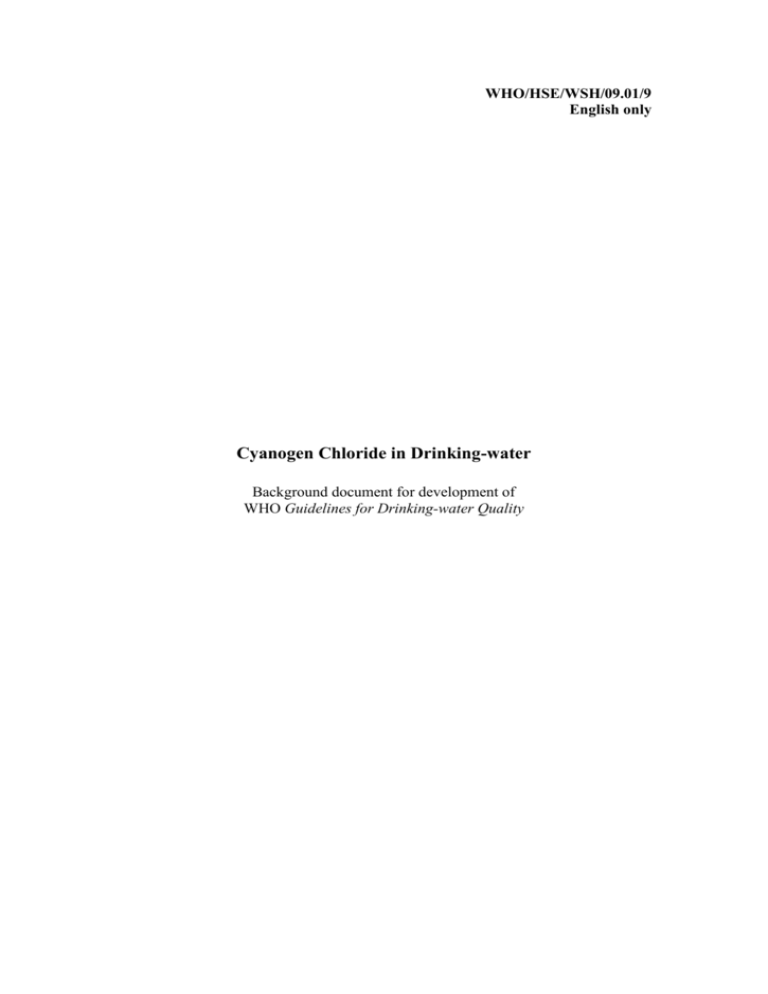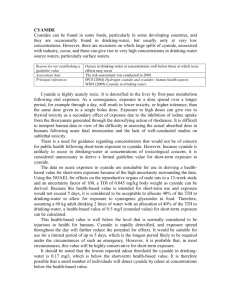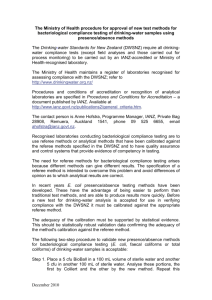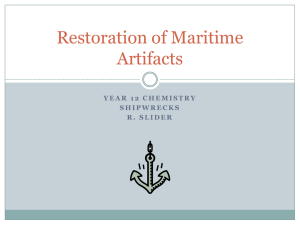
WHO/HSE/WSH/09.01/9
English only
Cyanogen Chloride in Drinking-water
Background document for development of
WHO Guidelines for Drinking-water Quality
Cyanogen Chloride in Drinking-water
Background document for development of WHO Guidelines for Drinking-water
Quality
World Health Organization 2009
All rights reserved. Publications of the World Health Organization can be obtained
from WHO Press, World Health Organization, 20 Avenue Appia, 1211 Geneva 27,
Switzerland (tel.: +41 22791 3264; fax: +41 22 791 4857; e-mail:
bookorders@who.int). Requests for permission to reproduce or translate WHO
publications—whether for sale or for non-commercial distribution—should be
addressed to WHO Press at the above address (fax: +41 22 791 4806; e-mail:
permissions@who.int).
The designations employed and the presentation of the material in this publication do
not imply the expression of any opinion whatsoever on the part of the World Health
Organization concerning the legal status of any country, territory, city or area or of its
authorities, or concerning the delimitation of its frontiers or boundaries. Dotted lines
on maps represent approximate border lines for which there may not yet be full
agreement.
The mention of specific companies or of certain manufacturers’ products does not
imply that they are endorsed or recommended by the World Health Organization in
preference to others of a similar nature that are not mentioned. Errors and omissions
excepted, the names of proprietary products are distinguished by initial capital letters.
All reasonable precautions have been taken by the World Health Organization to
verify the information contained in this publication. However, the published material
is being distributed without warranty of any kind, either expressed or implied. The
responsibility for the interpretation and use of the material lies with the reader. In no
event shall the World Health Organization be liable for damages arising from its use.
The named authors alone are responsible for the views expressed in this publication.
Printed by the WHO Document Production Services, Geneva, Switzerland
Preface
One of the primary goals of the World Health Organization (WHO) and its Member
States is that “all people, whatever their stage of development and their social and
economic conditions, have the right to have access to an adequate supply of safe
drinking water”. A major WHO function to achieve such goals is the responsibility
“to propose ... regulations, and to make recommendations with respect to international
health matters ....”
The first WHO document dealing specifically with public drinking-water quality was
published in 1958 as International Standards for Drinking-water. It was subsequently
revised in 1963 and in 1971 under the same title. In 1984–1985, the first edition of the
WHO Guidelines for Drinking-water Quality (GDWQ) was published in three
volumes: Volume 1, Recommendations; Volume 2, Health criteria and other
supporting information; and Volume 3, Surveillance and control of community
supplies. Second editions of these volumes were published in 1993, 1996 and 1997,
respectively. Addenda to Volumes 1 and 2 of the second edition were published in
1998, addressing selected chemicals. An addendum on microbiological aspects
reviewing selected microorganisms was published in 2002. The third edition of the
GDWQ was published in 2004, the first addendum to the third edition was published
in 2006 and the second addendum to the third edition was published in 2008. The
fourth edition will be published in 2011.
The GDWQ are subject to a rolling revision process. Through this process, microbial,
chemical and radiological aspects of drinking-water are subject to periodic review,
and documentation related to aspects of protection and control of public drinkingwater quality is accordingly prepared and updated.
Since the first edition of the GDWQ, WHO has published information on health
criteria and other supporting information to the GDWQ, describing the approaches
used in deriving guideline values and presenting critical reviews and evaluations of
the effects on human health of the substances or contaminants of potential health
concern in drinking-water. In the first and second editions, these constituted Volume 2
of the GDWQ. Since publication of the third edition, they comprise a series of freestanding monographs, including this one.
For each chemical contaminant or substance considered, a lead institution prepared a
background document evaluating the risks for human health from exposure to the
particular chemical in drinking-water. Institutions from Canada, Japan, the United
Kingdom and the United States of America (USA) prepared the documents for the
fourth edition.
Under the oversight of a group of coordinators, each of whom was responsible for a
group of chemicals considered in the GDWQ, the draft health criteria documents were
submitted to a number of scientific institutions and selected experts for peer review.
Comments were taken into consideration by the coordinators and authors. The draft
documents were also released to the public domain for comment and submitted for
final evaluation by expert meetings.
During the preparation of background documents and at expert meetings, careful
consideration was given to information available in previous risk assessments carried
out by the International Programme on Chemical Safety, in its Environmental Health
Criteria monographs and Concise International Chemical Assessment Documents, the
International Agency for Research on Cancer, the Joint FAO/WHO Meetings on
Pesticide Residues and the Joint FAO/WHO Expert Committee on Food Additives
(which evaluates contaminants such as lead, cadmium, nitrate and nitrite, in addition
to food additives).
Further up-to-date information on the GDWQ and the process of their development is
available on the WHO Internet site and in the current edition of the GDWQ.
Acknowledgements
The first draft of Cyanogen Chloride in Drinking-water, Background document for
development of WHO Guidelines for Drinking-water Quality, was prepared by Mr
J.K. Fawell, United Kingdom, and by Dr N. Chiu, United States Environmental
Protection Agency, with the assistance of the Water, Air and Climate Change Bureau
of Health Canada, to whom special thanks are due. It is an update of the background
document published in the second edition of the GDWQ in 1993.
The work of the following working group coordinators was crucial in the
development of this document and others contributing to the fourth edition:
Dr J. Cotruvo, J. Cotruvo & Associates, USA (Materials and chemicals)
Mr J.K. Fawell, United Kingdom (Naturally occurring and industrial
contaminants and Pesticides)
Ms M. Giddings, Health Canada (Disinfectants and disinfection by-products)
Mr P. Jackson, WRc-NSF, United Kingdom (Chemicals – practical aspects)
Professor Y. Magara, Hokkaido University, Japan (Analytical achievability)
Dr Aiwerasia Vera Festo Ngowi, Muhimbili University of Health and Allied
Sciences, United Republic of Tanzania (Pesticides)
Dr E. Ohanian, Environmental Protection Agency, USA (Disinfectants and
disinfection by-products)
The draft text was discussed at the Expert Consultation for the fourth edition of the
GDWQ, held on 19–23 June 2008. The final version of the document takes into
consideration comments from both peer reviewers and the public. The input of those
who provided comments and of participants at the meeting is gratefully
acknowledged.
The WHO coordinators were Mr R. Bos and Mr B. Gordon, WHO Headquarters. Ms
C. Vickers provided a liaison with the International Programme on Chemical Safety,
WHO Headquarters. Mr M. Zaim, Public Health and the Environment Programme,
WHO Headquarters, provided input on pesticides added to drinking-water for public
health purposes.
Ms P. Ward provided invaluable administrative support at the Expert Consultation
and throughout the review and publication process. Ms M. Sheffer of Ottawa, Canada,
was responsible for the scientific editing of the document.
Many individuals from various countries contributed to the development of the
GDWQ. The efforts of all who contributed to the preparation of this document and in
particular those who provided peer or public domain review comments are greatly
appreciated.
Acronyms and abbreviations used in the text
CAS
FAO
GDWQ
LC50
LD50
NOAEL
ppm
TDI
USA
WHO
Chemical Abstracts Service
Food and Agriculture Organization of the United Nations
Guidelines for Drinking-water Quality
median lethal concentration
median lethal dose
no-observed-adverse-effect level
parts per million
tolerable daily intake
United States of America
World Health Organization
Table of contents
1. GENERAL DESCRIPTION ...................................................................................... 1
1.1 Identity ................................................................................................................. 1
1.2 Physicochemical properties ................................................................................. 1
1.3 Major uses and sources in drinking-water ........................................................... 1
1.4 Environmental fate ............................................................................................... 1
2. ENVIRONMENTAL LEVELS AND HUMAN EXPOSURE ................................. 1
3. KINETICS AND METABOLISM IN LABORATORY ANIMALS AND
HUMANS ...................................................................................................................... 2
4. EFFECTS ON LABORATORY ANIMALS AND IN VITRO TEST SYSTEMS ... 2
5. EFFECTS ON HUMANS .......................................................................................... 2
6. PRACTICAL ASPECTS ........................................................................................... 2
6.1 Analytical methods and analytical achievability ................................................. 2
6.2 Treatment and control methods and performance ............................................... 2
7. CONCLUSION .......................................................................................................... 2
8. REFERENCES .......................................................................................................... 3
1. GENERAL DESCRIPTION
1.1 Identity
Chemical Abstracts Service (CAS) No.:
506-77-4
Molecular formula:
CNCl
1.2 Physicochemical properties
Some important physical and chemical properties of cyanogen chloride are
summarized in Table 1.
Table 1. Physicochemical properties of cyanogen chloride
Property
Value
Boiling point
12.7 °C
Melting point
−6 °C
Density
1.186 g/cm3 at 20 °C
Henry’s law constant
2.48 kPa·m3/mol
Water solubility
Very soluble
Sources: Verschueren (1977); Weast (1988); Budavari, O’Neill & Smith (1989); SRC (2006).
The conversion factor for cyanogen chloride in air is 1 ppm = 2.5 mg/m3.
1.3 Major uses and sources in drinking-water
Cyanogen chloride is used in tear gas, in fumigant gases and as a reagent in the
synthesis of other compounds (Hawley, 1981). Cyanogen chloride may be formed as a
by-product of chloramination or chlorination of water. It is also formed by the
chlorination of cyanide ion present in raw water.
1.4 Environmental fate
Cyanogen chloride is unstable in the presence of free chlorine; for example, its halflife in chlorinated water containing a free chlorine concentration of 0.5 mg/l was
approximately 1 h (Na & Olson, 2004). At high pH, it is hydrolysed to release cyanide
ions (Xie & Reckhow, 1992). Its estimated Henry’s law constant of 2.48 kPa·m3/mol
suggests a significant potential for volatilization (SRC, 2006).
2. ENVIRONMENTAL LEVELS AND HUMAN EXPOSURE
Cyanogen chloride has been found in finished water supplies, usually at
concentrations below 10 µg/l. The concentration in water when chlorination was used
for disinfection was reported to be 0.4 µg/l. The level was higher (1.6 µg/l) in
chloraminated water (Krasner et al., 1989).
1
CYANOGEN CHLORIDE IN DRINKING-WATER
3. KINETICS AND METABOLISM IN LABORATORY ANIMALS AND
HUMANS
In an in vitro study with rat blood, cyanogen chloride was metabolized to cyanide ion
by haemoglobin and glutathione (Aldridge, 1951).
4. EFFECTS ON LABORATORY ANIMALS AND IN VITRO TEST SYSTEMS
Estimates of inhalation median lethal concentrations (LC50s) range from 100 mg/m3 in
cats to 7536 mg/m3 in rabbits (Tarken & Lewis, 1983). In other lethality tests, a
concentration of 100 mg/m3 was fatal to cats within 18 min, 120 mg/m3 for 6 h was
fatal to dogs, 5 mg/m3 for 2 min was fatal to goats and a subcutaneous dose of 20
mg/kg body weight was fatal to rabbits (Flury & Zernik, 1931). A median lethal dose
(LD50) of 6 mg/kg body weight was reported in rats following oral administration
(Leitch & Bauer, 1945). Toxic signs included irritation of the respiratory tract,
haemorrhagic exudate of the bronchi and trachea, and pulmonary oedema.
5. EFFECTS ON HUMANS
On inhalation, a concentration of 2.5 mg/m3 causes irritation. Cyanogen chloride was
used as a war gas in the First World War. A concentration of 120 mg/m3 was lethal
(NAS, 1977).
6. PRACTICAL ASPECTS
6.1 Analytical methods and analytical achievability
United States Environmental Protection Agency Method 524.2, in which purge-andtrap gas chromatography is combined with mass spectroscopy, can be used for the
determination of cyanogen chloride. This method has a practical quantification limit
of 0.3 µg/l (USEPA, 1991).
6.2 Treatment and control methods and performance
There is little information available on the removal of cyanogen chloride, and
information on its stability in the distribution system is ambiguous (i.e. its
concentration can increase or decrease). However, it is known to be unstable in
chlorinated water (Na & Olson, 2004). Cyanogen chloride can be removed by
chemical reduction agents such as sodium sulfite, sodium disulfite and sodium
thiosulfate (Shang et al., 2005).
7. CONCLUSION
Cyanogen chloride is rapidly metabolized to cyanide in the body. There are few data
available on the oral toxicity of cyanogen chloride.
As cyanogen chloride is unlikely to be found in drinking-water at concentrations that
are of toxicological concern, it is considered unnecessary to develop a formal
guideline for cyanogen chloride. Instead, for guidance purposes, a health-based value
2
CYANOGEN CHLORIDE IN DRINKING-WATER
is derived based on cyanide (for a review of the toxicology of cyanide, see the
background document on cyanide: WHO, 2009).
The no-observed-adverse-effect level (NOAEL) in a rat chronic study in which
cyanide was administered in the feed with the use of special jars to minimize loss by
volatilization was 10.8 mg/kg body weight per day (Howard & Hanzal, 1955). The
NOAEL in a more recent subchronic study in which rats were exposed through their
drinking-water was 4.5 mg/kg body weight per day as cyanide for minor changes in
the testis (NTP, 1993). This latter study was selected as the critical study on which to
base the health-based value. In view of the minor nature of the changes observed and
the NOAEL in a previous chronic study, it is not considered necessary to include an
additional uncertainty factor to allow for extrapolation from subchronic to chronic
exposure. Further, it appears that a dose that may be toxic in acute poisoning (Gettler
& Baine, 1938) would certainly be tolerated under chronic conditions, owing to
efficient detoxification (Cleven & van Bruggen, 2000). The application of an
uncertainty factor of 100 for interspecies and intraspecies variability to the NOAEL of
4.5 mg/kg body weight gives a tolerable daily intake (TDI) of 0.045 mg/kg body
weight as cyanide (corresponding to 0.11 mg/kg body weight as cyanogen chloride).
Assuming a 60 kg adult drinking 2 litres of water per day and allowing 20% of the
TDI to come from water because of the potential for exposure to cyanogenic
glycosides in food (WHO, 2009), the health-based value for long-term exposure is 0.3
mg/l as cyanide or 0.6 mg/l as cyanogen chloride (rounded values).
Although low concentrations of cyanide in raw waters will be converted to cyanogen
chloride by chlorination, cyanogen chloride may also be formed during the production
of chloramines in situ as a residual disinfectant to maintain the hygienic condition of
the distribution system. It is important that treatment be optimized to minimize the
formation of cyanogen chloride while maintaining adequate chloramine residuals
where chloramination is practised.
8. REFERENCES
Aldridge WN (1951) The conversion of cyanogen chloride to cyanide in the presence of blood proteins
and sulphydryl compounds. Biochemical Journal, 48: 271–276 [cited in NAS, 1977].
Budavari S, O’Neill M, Smith A, eds. (1989) The Merck index. An encyclopedia of chemicals, drugs,
and biologicals, 11th ed. Rahway, NJ, Merck.
Cleven RFMJ, van Bruggen M (2000) The cyanide accident in Barskoon (Kyrgyzstan). Bilthoven,
National Institute of Public Health and the Environment (Report No. 609026 001).
Flury F, Zernik F (1931). [Harmful gases.] Berlin, Springer [cited in NAS, 1977].
Gettler AO, Baine JO (1938) The toxicity of cyanide. American Journal of Medical Science, 195:182–
198.
Hawley GG (1981) The condensed chemical dictionary, 10th ed. New York, NY, Van Nostrand
Reinhold, p. 241.
Howard JW, Hanzal RF (1955) Chronic toxicity for rats of food treated with hydrogen cyanide.
Agricultural and Food Chemistry, 3: 325–329.
Krasner SW et al. (1989) The occurrence of disinfection by-products in U.S. drinking water. Journal of
the American Water Works Association, 81(8): 41–53.
3
CYANOGEN CHLORIDE IN DRINKING-WATER
Leitch JL, Bauer VE (1945) Oral toxicity of cyanogen chloride in water to rats. Edgewood Arsenal,
MD, United States Chemical Warfare Service (Medical Division Report No. 19) [cited in NAS, 1977].
Na C, Olson TM (2004) Stability of cyanogen chloride in the presence of free chlorine and
monochloramine. Environmental Science and Technology, 38(22): 6037–6043.
NAS (1977) Drinking water and health. Washington, DC, National Academy of Sciences.
NTP (1993) Sodium cyanide administered in drinking water to F344/N rats and B6C3F1 mice.
Research Triangle Park, NC, National Institutes of Health, National Toxicology Program (Toxicology
Report Series No. 37; NIH Publication 94-3386).
Shang C et al. (2005) Kinetics of cyanogen chloride destruction by chemical reduction methods. Water
Research, 39(10): 2114–2124.
SRC (2006) Interactive physical properties database. Syracuse, NY, Syracuse Research Corporation
(http://www.syrres.com).
Tarken RL, Lewis RJ Sr, eds (1983) Registry of toxic effects of chemical substances. Vol. 2, 1981–82
ed. Cincinnati, OH, National Institute for Occupational Safety and Health (DHHS (NIOSH) Publication
No. 83-107).
USEPA (1991) Method 524.2: Measurement of purgeable organic compounds in water by capillary
column gas chromatography/mass spectrometry. In: Methods for the determination of organic
compounds in drinking water. Cincinnati, OH, United States Environmental Protection Agency, Office
of Research and Development, Environmental Monitoring Systems Laboratory (EPA-600/4-88/039,
December 1988, revised July 1991).
Verschueren K (1977) Handbook of environmental data on organic chemicals. New York, NY, Van
Nostrand Reinhold.
Weast RC (1988) Handbook of chemistry and physics. Cleveland, OH, CRC Press.
WHO (2009) Cyanide in drinking-water. Background document for development of WHO Guidelines
for drinking-water quality. Geneva, World Health Organization (WHO/HSE/WSH/09.01/3).
Xie Y, Reckhow DA (1992) Stability of cyanogen chloride in the presence of sulphite and chlorine. In:
Proceedings of the American Water Works Association Water Quality Technology Conference,
Toronto, Ontario, November. Denver, CO, American Water Works Association.
4









